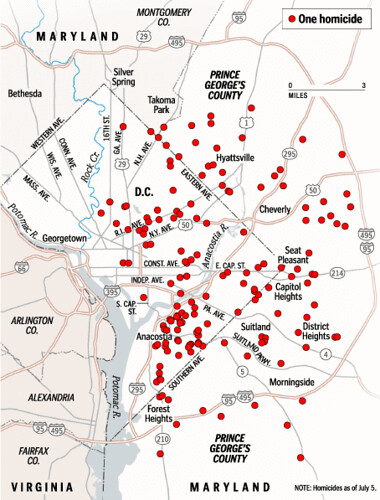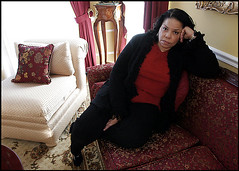People killing people is the problem
 Washington Post graphic from July. (See these July blog entries: "I don't read the Post first thing in the morning..." and "In a rising real estate tide, some communities get swamped.")
Washington Post graphic from July. (See these July blog entries: "I don't read the Post first thing in the morning..." and "In a rising real estate tide, some communities get swamped.") The Washington Times had a book review of a book entitled Think which apparently is a "conservative" response to Malcolm Gladwell's Blink (which isn't all that, but is well-written). One of the points that the book Think makes is that some social problems are insolvable.
I don't believe that. But I do believe that social problems are insolvable when the manner in which the problems are addressed is faulty. (In the last week, the Financial Times had a column on the "Poisson Distribution." As the article says: "The Poisson distribution was discovered through observation of the process of fermentation in beer. The t-statistic is a measure of how much confidence can be placed in judgments made from small samples. Gossett invented that measure to enable the quality of brews to be monitored in a cost-effective manner." Too rarely do we apply such precise methods of analysis to social issues that are addressed most often by local governments.)
One of the biggest 2005 stories in the Washington metropolitan area has been the increase in the murder rate in Prince George's County, Maryland. There are many reasons bandied about for why this is so. The reality is that murder rates track socioeconomic status and the violence quotient (murder rates by race). Other factors influence this but the only way to impact murder rates is to reduce people's propensity for violence.
Other types of crime can be impacted by problem-oriented policing, catching and imprisoning criminals. And places like Baltimore, which has a high murder rate due to the prevalence of drug addiction, and DC are experiencing crime rate drops even as the murder rates seem resistant to reduction (although these rates are far lower than rates experienced in the late 1980s through the mid 1990s--DC is under 1/2 its peak murder rate of a decade ago). (See today's Post editorial about Baltimore, Murder in Baltimore.)
Because of political correctness, people tend not to focus on these key facts. Even though Boston's murder rate has gone up in the last year, that city has been particularly effective in getting at the "culture of violence," reducing it, and therefore reducing murder rates to unheard of lows for a demographic mix and population of the size of Boston.
The book The Future Once Happened Here discusses how the migration of people from the south overwhelmed northern cities and social institutions unable to respond to the culture of violence that came along with the migrants. Before people jump on me about this, it's not necessarily a race thing. White southerners created this culture and socialized it. The Hatfields and the McCoys had nothing to do with racism...
I can't remember if I mentioned that the January-February issue of Mother Jones magazine has a great piece on reducing the culture of violence in gang culture, with particular attention to Boston and Los Angeles. You'll have to buy a copy of the issue though because the story, "Straight Outta Boston," is not online.
In short, when PG County Police Chief Melvin High says "As density goes, that creates issues, it comes down to rage, tremendous human rage," I hope that he is not criticizing what he sees as the problems from urban form, but the problems that result from putting together in close quarters a lot of people with a propensity for violence... (Quoted in "D.C. Area Slayings Climbed In 2005" in the Post.)
I don't have much sympathy for Prince George's residents that have lost their sense of refuge (see "Pr. George's Community a Sanctuary No More: Residents Who Fled D.C. Crime Bolster Security Efforts or Ponder Next Move") because they abandoned the problems of the poor by moving out of the city. Now that the problems have followed them to their suburban idyll, they're concerned.
For all those other years, they probably paid no mind to what I think of as the positive quality of life subsidy provided to Washington suburbs on the backs of DC residents, because the majority of the poorest and most violent citizens in the area live/lived in DC, in a number disproportionate to DC's percentage of the region's population. As the SES distribution changes, so do violence rates among the various jurisdictions.
 She moved too early. "Sometimes it feels like crime is everywhere in Prince George's," said Pamela Gaines, who moved from Dupont Circle to Woodmore South, a subdivision in Mitchellville, nine years ago. Post photo by Lois Raimundo.
She moved too early. "Sometimes it feels like crime is everywhere in Prince George's," said Pamela Gaines, who moved from Dupont Circle to Woodmore South, a subdivision in Mitchellville, nine years ago. Post photo by Lois Raimundo.Index Keywords: quality-of-life-advocacy



0 Comments:
Post a Comment
<< Home